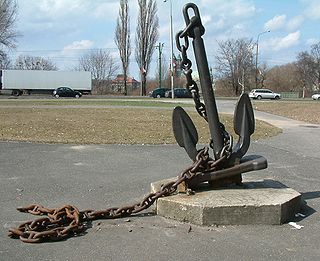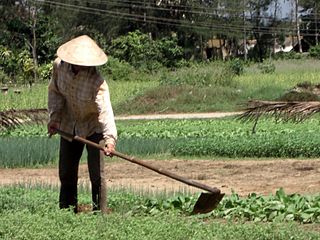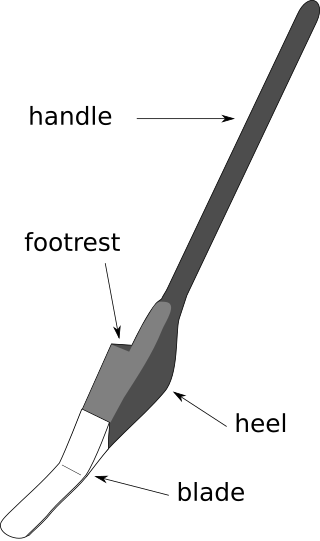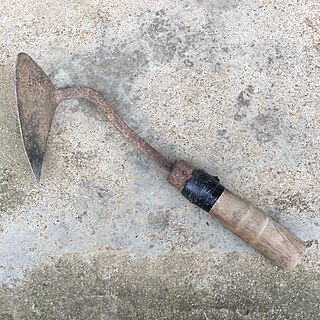
An anchor is a device, normally made of metal, used to secure a vessel to the bed of a body of water to prevent the craft from drifting due to wind or current. The word derives from Latin ancora, which itself comes from the Greek ἄγκυρα.

A plough or plow is a farm tool for loosening or turning the soil before sowing seed or planting. Ploughs were traditionally drawn by oxen and horses but in modern farms are drawn by tractors. A plough may have a wooden, iron or steel frame with a blade attached to cut and loosen the soil. It has been fundamental to farming for most of history. The earliest ploughs had no wheels; such a plough was known to the Romans as an aratrum. Celtic peoples first came to use wheeled ploughs in the Roman era.

A chisel is a tool with a characteristically shaped cutting edge of blade on its end, for carving or cutting a hard material such as wood, stone, or metal by hand, struck with a mallet, or mechanical power. The handle and blade of some types of chisel are made of metal or of wood with a sharp edge in it.

The kukri or khukuri is a type of short sword with a distinct recurve in its blade originated in the Indian subcontinent. It serves multiple purposes as a melee weapon and also as a regular cutting tool throughout most of South Asia. The kukri, khukri, and kukkri spellings are of Indian English origin, with the original Nepalese English spelling being khukuri.

A shovel is a tool used for digging, lifting, and moving bulk materials, such as soil, coal, gravel, snow, sand, or ore.

A mattock is a hand tool used for digging, prying, and chopping. Similar to the pickaxe, it has a long handle and a stout head which combines either a vertical axe blade with a horizontal adze, or a pick and an adze. A cutter mattock is similar to a Pulaski used in fighting fires. It is also commonly known in North America as a "grub axe".

A hoe is an ancient and versatile agricultural and horticultural hand tool used to shape soil, remove weeds, clear soil, and harvest root crops. Shaping the soil includes piling soil around the base of plants (hilling), digging narrow furrows (drills) and shallow trenches for planting seeds or bulbs. Weeding with a hoe includes agitating the surface of the soil or cutting foliage from roots, and clearing the soil of old roots and crop residues. Hoes for digging and moving soil are used to harvest root crops such as potatoes.
A spatula is a broad, flat, flexible blade used to mix, spread and lift material including foods, drugs, plaster and paints.

A trowel is a small hand tool used for digging, applying, smoothing, or moving small amounts of viscous or particulate material. Common varieties include the masonry trowel, garden trowel, and float trowel.

A digging stick, sometimes called a yam stick, is a wooden implement used primarily by subsistence-based cultures to dig out underground food such as roots and tubers, tilling the soil, or burrowing animals and anthills. It is a term used in archaeology and anthropology to describe similar implements, which usually consists of little more than a sturdy stick which has been shaped or sharpened and sometimes hardened by being placed temporarily in a fire.

Seax is an Old English word for "knife". In modern archaeology, the term seax is used specifically for a type of small sword, knife or dagger typical of the Germanic peoples of the Migration Period and the Early Middle Ages, especially the Saxons, whose name derives from the weapon. These vary considerably in size.
The spurtle is a wooden Scottish kitchen tool, dating from the 15th century, that is used to stir porridge, soups, stews, and broths.

The foot plough is a type of plough used like a spade with the foot in order to cultivate the ground.

An entrenching tool (U.K.), intrenching tool (U.S.), E-tool, or trenching tool is a digging tool used by military forces for a variety of military purposes. Survivalists, campers, hikers and other outdoors groups have found it to be indispensable in field use. Modern entrenching tools are usually collapsible and made using steel, aluminum, or other light metals.

A number of common weeding tools are designed to ease the task of removing weeds from gardens and lawns.

The Masonry trowel is a hand trowel used in brickwork or stonework for levelling, spreading and shaping mortar or concrete. They come in several shapes and sizes depending on the task. The following is a list of the more common masonry trowels:

A digging bar is a long, straight metal bar used for various purposes, including as a post hole digger, to break up or loosen hard or compacted materials such as soil, rock, concrete and ice or as a lever to move objects. Known by other names depending on locale, structural features and intended purpose such as a hop bar or crowbar in Britain, Australia and New Zealand, and slate bar, shale bar, spud bar, pinch point bar or San Angelo bar in North America, or just a bar. In Hawaii, a similar, traditional wooden device known as an ‘o‘o stick is used as a digging bar in groundbreaking ceremonies. Not to be confused with a curved crowbar, which is designed to provide leverage rather than to dig.

A loy is an early Irish spade with a long heavy handle made of ash, a narrow steel plate on the face and a single footrest. The word loy comes from the Irish word láí, which means "spade". It was used for manual ploughing prior to and during the Great Famine.

A snow shovel is a specialized shovel designed for snow removal. Snow shovels come in several different designs, each of which is designed to move snow in a different way. Removing snow with a snow shovel has health and injury risks, but can also have significant health benefits when the snow shovel is used correctly.

Homi, also known as a Korean hand plow, is a short-handled traditional farming tool used by Koreans. It is a farming tool that removes grasses from paddies and fields. It is also used when plowing a rice field, planting seeds, plowing up soil, and digging potatoes in fields. It is a farming tool similar to the hoe. It is an important extension of agriculture from the ancient times because the homi was excavated in the Bronze Age historic site of the Pyeongnam Mangsan Daepyeong-ri and the early Iron Age historic site of Yangpyong, Gyeonggi Province.


















